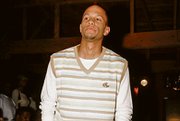Urban Apparel Makers Tailor Strategies for Growth
Despite some recent hiccups, the urban-apparel market is riding another wave of growth fueled by endorsements from the country’s leading rap and hip-hop artists, and by a spate of retooling among the market leaders.
A little more than a year ago, major department and specialty stores were culling brands and styles, leaving piles of merchandise for the jobbers and off-price market.
But urbanwear designers have shifted gears and brought back more tailored styling while capitalizing on star power for marketing. The formula apparently has worked. New York–based researcher Packaged Facts released a report showing that the hip-hop apparel and peripheral industries have grown to $500 million.
The changes to be seen will come via more downplayed styling. New York–based Rocawear just debuted Custom Fit, a line that de-emphasizes the big logos and favors a slim rather than baggy silhouette.
“A lot of the original urban customers are maturing now, so it looks like a smart move,” said Chris Leogrande, vice president of buying and planning for Seacaucus, N.J.–based e-Fashion Solutions, which runs the e-commerce operations for a number of urban brands, including Rocawear, Phat Farm, Apple Bottoms, Kimora Lee Simmons and others.
The more-tailored looks are also aimed at expanding these brands into the department/specialty store channel.
Los Angeles urban apparel designer and fashion-show producer Billy Foster calls it “urban couture.”
Foster’s most recent event was the Los Angeles Urban Fashion Week, held over New Year’s weekend at several clubs in Hollywood. The events drew upand- coming lines such as Jazzy Raggs and Dezire Designs as well as market leaders such as 50 Cent’s G-Unit, Ecko, Avirex and Ed Hardy.
While Foster is trying to promote up-and-coming West Coast brands, the New York labels continue to rule the marketplace, noted Leogrande.
“Right now, the Rocawear business is on fire. Dereon and the House of Dereon are amazing,” he said.
While product is usually king, the fact that these lines are backed by musicians Shawn “Jay-Z” Carter and Beyonceacute; Knowles, respectively, goes just as far in bringing in the sales, said Leogrande.
“Jay-Z is loved by his fans,” he continued. “He’s active with his brands, wearing the clothes in videos, appearances, just about everywhere he goes. The same goes for Beyonceacute;.”
Other name endorsers have not been as committed, and the results have materialized, said Leogrande.
Foster agreed: “You have to follow through. A lot of these endorsers think they can lend their name and sit back and enjoy the royalties. You have to be committed.”
Case in point, said one urban clothing buyer, was Jennifer Lopez’s J-Lo by Jennifer Lopez apparel line. “She launched J-Lo, but later that same year, she was modeling for LV [Louis Vuitton],” said the source, who requested to remain anonymous.
The Packaged Facts report said the largest consumer group for urban clothing consists of the 24 million 15- to 29-year-olds who have some type of connection to hip-hop music and culture. The report also noted that this group will spend majority portions of their income to wear the same clothing as their rap heroes.
Alex Vigo, a buyer with Laguna Hills, Calif.–based ClubUrban.com, one of the country’s largest urban etailers, said there’s little price resistance right now for brands such as G-Unit, Ecko and Rocawear.
“Especially with all the new stuff coming in—they’re willing to pay for it,” he said.
The women’s market, in particular, has been hot, said Vigo, especially with brands such as G-Unit and Ecko. Leograndee said female consumers are eating up blinged-up velour track suits and printed hoodies.
Vigo said up-and-coming brands such as Lot 29, which is distributed by New York–based Southpole, have been making inroads by selling at price points significantly lower than that of mainstream brands. The company is doing well right now with Looney Tunes character tees selling from $28 and up.
Urbanwear manufacturers said they are also being supported by international sales, especially in Britain, where sales of American urban labels are skyrocketing.






















